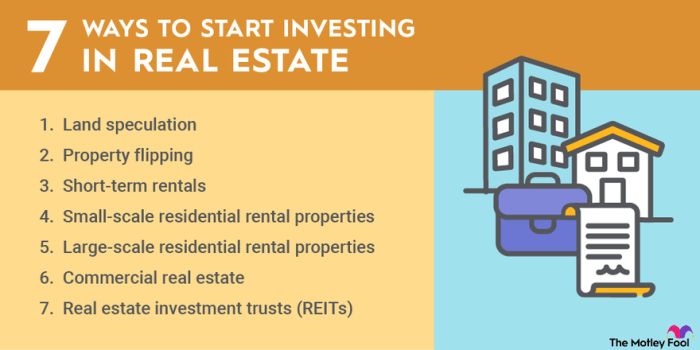How to insure your real estate investment property: A Comprehensive Guide
How to insure your real estate investment property sets the stage for this informative discussion, offering readers valuable insights into protecting their investments with the right insurance coverage. Throughout this guide, you will uncover essential tips and strategies to safeguard your property effectively.
Understanding Insurance Needs

Real estate investment properties are valuable assets that require protection through insurance coverage. Insuring your investment property is essential to safeguard against potential risks and liabilities that may arise.
Types of Insurance Coverage
- Property Insurance: Provides coverage for damages to the physical structure of the property, including the building and any fixtures.
- Liability Insurance: Protects against claims or lawsuits filed by third parties for injuries or damages that occur on the property.
- Rental Income Insurance: Covers lost rental income if the property becomes uninhabitable due to a covered loss.
- Landlord Insurance: Specifically designed for rental properties, offering a combination of property and liability coverage.
Risks of Not Insuring Your Investment Property
- Financial Loss: Without insurance, you could be responsible for costly repairs or legal expenses in the event of property damage or liability claims.
- Lack of Protection: Your investment property is vulnerable to various risks, such as natural disasters, accidents, or tenant disputes, without adequate insurance coverage.
- Legal Consequences: Non-compliance with insurance requirements or failure to address liabilities can result in legal repercussions and financial repercussions.
Selecting the Right Insurance Policy
When it comes to insuring your real estate investment property, choosing the right insurance policy is crucial. This decision can impact your financial security in case of unexpected events such as natural disasters, accidents, or tenant-related issues. Here are some tips on how to select the best insurance coverage for your specific property.
Comparing Different Insurance Policies
- Research and compare various insurance policies tailored for real estate investment properties.
- Consider factors such as coverage limits, exclusions, premiums, and reputation of the insurance provider.
- Look for policies that offer comprehensive coverage for common risks faced by landlords.
Choosing the Best Insurance Coverage
- Evaluate the specific needs of your property and the level of protection required.
- Consider the location of your property and the likelihood of certain risks, such as floods, earthquakes, or vandalism.
- Consult with insurance agents or brokers who specialize in real estate investment properties to get expert advice.
Factors to Consider When Selecting an Insurance Policy
- Cost: Compare premiums from different insurers and choose a policy that offers good value for money.
- Coverage: Ensure that the policy covers essential risks like property damage, liability protection, and loss of rental income.
- Deductibles: Understand the deductible amount you will be responsible for in case of a claim and choose a deductible that fits your budget.
Insurance Claim Process

When it comes to filing an insurance claim for your real estate investment property, there are specific steps you need to follow to ensure a smooth process. Understanding what documentation is required and the typical timeline for processing the claim is crucial for a successful outcome.
Steps in Filing an Insurance Claim
- Contact your insurance company immediately after discovering the damage to your property.
- Provide necessary details such as policy number, date of damage, and a description of what happened.
- An insurance adjuster will be assigned to assess the damage and determine the coverage.
- Document all damages with photographs and receipts for repairs or replacements.
- Complete any claim forms required by your insurance company accurately and promptly.
Documentation Required for Filing an Insurance Claim
- Policy documents: Provide your insurance policy details and any relevant endorsements.
- Proof of ownership: Documents showing you are the owner of the property.
- Photos: Visual evidence of the damage before any repairs or cleanup.
- Estimates: Quotes from contractors for repair or replacement costs.
- Receipts: Keep track of all expenses related to the damage for reimbursement.
Timeline for Processing an Insurance Claim
Typically, insurance companies aim to process claims within 30 days of receipt. However, the timeline can vary depending on the complexity of the claim and the extent of the damage.
Risk Mitigation Strategies
When it comes to real estate investment properties, minimizing risks is crucial to protect your investment. By implementing proper maintenance and risk management strategies, you can not only reduce the likelihood of insurance claims but also potentially lower your insurance premiums.
Regular Property Inspections
One of the key preventive measures is conducting regular property inspections. By identifying and addressing maintenance issues early on, you can prevent small problems from turning into costly repairs. This proactive approach can help maintain the condition of your property and reduce the risk of unexpected damages.
Tenant Screening Process
Another important risk mitigation strategy is to have a thorough tenant screening process in place. By selecting responsible and reliable tenants, you can minimize the risk of property damage or payment defaults. Conducting background checks, verifying income, and checking references can help you find tenants who are more likely to take care of your property.
Insurance Policy Review
Regularly reviewing your insurance policy is essential to ensure that you have adequate coverage for your investment property. As property values and risks can change over time, it's important to update your policy accordingly. By understanding the terms and coverage limits of your insurance policy, you can avoid potential gaps in coverage and ensure that you are adequately protected.
Ending Remarks
In conclusion, ensuring your real estate investment property is not just a financial decision but a crucial step in protecting your assets. By understanding the insurance needs, selecting the right policy, knowing the claims process, and implementing risk mitigation strategies, you can secure your investment for the long term.
Quick FAQs
What types of insurance coverage are available for investment properties?
Common types include landlord insurance, dwelling coverage, liability insurance, and loss of rental income coverage.
How do I choose the best insurance coverage for my property?
Consider factors like the property's location, value, rental income, and potential risks to determine the most suitable coverage.
What documentation is needed when filing an insurance claim for property damage?
You may need to provide photos of the damage, repair estimates, police reports (if applicable), and any relevant insurance policy documents.
How can proper maintenance impact insurance premiums?
Regular maintenance can reduce the likelihood of claims, showcasing to insurers that your property is well-cared for, potentially leading to lower premiums.



